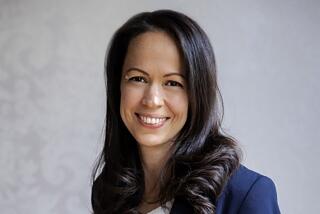Futurist Sees Machines, Humans Merging in 2045
- Share via
Ray Kurzweil, an inventor and futurist, has stumbled on a discovery of earth-shattering importance. It is the arrival of “singularity,” and according to him it will happen in 2045.
“Gradually,” he writes at the beginning of “The Singularity Is Near,” “I’ve become aware of a transforming event looming in the first half of the 21st century ... the impending Singularity in our future is increasingly transforming every institution and aspect of human life, from sexuality to spirituality.”
Singularity, Kurzweil says, is a development “representing a profound and disruptive transformation in human capability” and a “radical upgrading of our bodies’ physical and mental systems.”
What are its elements? Kurzweil maintains that the first half of the 21st century will be characterized by three overlapping revolutions: human genetics, robotics or artificial intelligence, and nanotechnology.
Biotechnology, advances in genomics and gene therapies will enable us to turn off disease and aging and thus live for much longer. Because we soon will be able to “reverse-engineer the brain” and simulate its functions, he claims, technology will increasingly merge with human intelligence to create something with greater capacity and speed. Nanotechnology, the science of small things, will enable us “to redesign and rebuild -- molecule by molecule -- our bodies and brains and the world with which we interact, going far beyond the limitations of biology.”
Kurzweil knows a lot about new technology, and he knows how to make it sound fun. He is dazzling in his enthusiasm for things to come, and he has a grasp of the exciting developments pulsing through the intersection of science and technology. He recognizes technology’s power to improve the lot of humankind and is skeptical of the doom-mongers who argue that it will lead to overpopulation or mass unemployment.
New technologies, Kurzweil recognizes, usually create new jobs for those displaced by it. Cloning, for example, is not as scary as it is made to sound, and might even offer solutions for world hunger, creating meat and other protein sources in a factory without animals by cloning animal muscle tissue.
But what is the evidence for “singularity” itself? Kurzweil has borrowed the metaphor from mathematics and physics, where it means something that has reached the stage of being infinite. He recognizes that singularity does not amount to anything that might be described as “infinite” in the social sphere, but he still believes that the metaphor is appropriate. Humans, he too often forgets, have always sought to transcend biology.
Kurzweil thinks we are turning into cyborgs -- part human, part machine -- but any old man with a walking stick might be seen as a cyborg too. Technology, it is important to remember, conducts its way through society as a series of quantitative heaves rather than a qualitative leap. He thinks that the exponentially increasing processing power of computers can help us understand the speed of social change. The changes he describes might look fast on paper, but they filter through to social life at a snail’s pace. Many of them do not make it at all because of a lack of investment or human enthusiasm.
Throughout his book Kurzweil capitalizes singularity. He even has a name for someone who is a follower of the faith: “I regard someone who understands the Singularity and who reflects on its implications for his or her own life as a ‘singularitarian.’ ”
He pays lip service to a kind of humanism -- “we will transcend biology, but not our humanity” -- but sounds like a religious evangelist, or a New Ager who has spent too long in front of a computer. Being human, Kurzweil rightly points out, “means being part of a civilization that seeks to extend its boundaries.” Is a human modified by technology no longer human? he wonders. The doom-mongers make it sound like a slippery slope, but Kurzweil envisages it as a kind of Second Coming, a technological Noah’s ark through which only true believers will pass.
Kurzweil pays tribute to the notion of human consciousness but seems to regard it as a lost cause in the long run. His determination to keep humans central to his vision is admirable but is not borne out by the thrust of his work, which suggests that he takes his spiritual sustenance from the machine part of the equation.
For Kurzweil, all that remains is an ethical problem, of how humanity adapts to the new post-singular world in which we have become outsmarted by machines. His metaphor of singularity plays well in the science-fiction community, among Hollywood scriptwriters in need of inspiration and among military spooks whose job it is to think ahead of the curve -- Kurzweil is one of five members of the science advisory group for the U.S. Army.
For us ordinary mortals, it is singularly unhelpful.
*
This review appears via special arrangement with the Financial Times, where it first appeared.
*
Looking ahead
* The Singularity Is Near: When Humans Transcend Biology
* By Ray Kurzweil
* Duckworth Publishers, $29.99, 652 pages
*
Source: Publisher
Los Angeles Times






